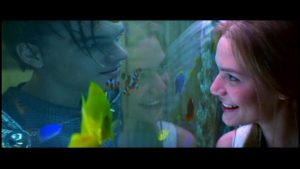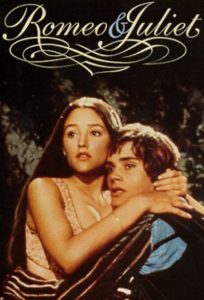Romeo and Juliet is a classic play by William Shakespeare that has been interpreted through many forms of media over the years. In particular, film directors Franco Zeffirelli and Baz Luhrmann are especially interesting on account of their contrasting takes of the story. They have distinct styles, which is immediately apparent upon watching both films. Comparing the same scene in each movie highlights the differences in choices Zeffirelli and Luhrmann make. The scene I will be focusing on here is Act 1 Scene 5, where Romeo attends the Capulet party and meets Juliet for the first time.
In the Baz Luhrmann version of this scene, the party starts off with high impact. It seems to be from Romeo’s point of view; he is interpreting the world after using drugs. The dizzying effect of slow motion, rapid cuts and close ups of character’s faces reflects Romeo’s experience at the party. This use of cinematography is paired with very bright colours, lights, and flashy costumes, all of which contribute to the frenetic energy of the sequence. The breathless activity finally culminates as Romeo dunks his head in water and comes to his senses. An immediate change of pace takes hold. The shots are longer, as there is slow panning of Romeo’s surroundings. A peaceful and romantic song is being sung over a quiet crowd, and Romeo enjoys the beauty of an aquarium. Very much like the fish swimming through the water, the mood is serene and dreamlike. Juliet’s appearance on the other side of the glass attracts Romeo’s attention and they watch each other for a long time through the water barrier. The soft blue lighting in this moment adds to the peaceful atmosphere.

Luhrmann’s approach to this scene seems to consist of volatile shifts — the rapid movement and energy in one sequence is immediately followed by calm and sensitivity in the next. I think this ultimately adds an element of mystery, especially when the dialogue is scarce. Up to this point, only two lines have been said by any of the characters. The shifts in mood within this scene continue with the overarching surrealism that is paramount in Luhrmann’s style. For example, Juliet is whisked away before Romeo can speak to her, and while she is dancing, he watches her in a kind of romantic daze. Though people are obviously talking in the background, it is not heard what is being said, because from Romeo’s perspective, Juliet is all that matters. Her movements are slowed down, and when it cuts back to reflect on Romeo’s face, his expression is one of awe. Once they are finally reunited, the feeling of intensity and danger returns — the audience knows that they are enemies, and the mood plays on that knowledge. The whispering delivery of the lines, the quick cuts and movements between faces all work up to the moment of their first kiss, which is fraught with peril by the prying eyes of Juliet’s clan.
The scene ends as Romeo runs off and Tybalt says the lines, “I will withdraw; but this intrusion shall/ Now with seeming sweet convert to bitter gall.” Romeo and Juliet (1.5.91-92) In the original play, these lines are spoken before Romeo and Juliet even meet, but their placement at the end of this scene is very impactful and closes the scene with a foreboding mood — foreshadowing what is to come later.

In contrast, Zeffirelli’s take on this scene is shorter, calmer, and more dialogue heavy. I’d go as far to compare it to the use of ‘soft romance’, which is characterized by innocence, sweetness, and overall security; as opposed to ‘hard romance’ which is far more dramatic and contains threatening elements. While Luhrmann’s take definitely incorporated the sense of threat into his scene, Zeffirelli focuses more on the festivity and the innocent curiosity of the two lovers. The cuts between characters are slower, the music calmer and there is a lot more talking in general. the sequence where Juliet dances within a whirlwind of people is exciting, but not the extent of madness like with Luhrmann. the while atmosphere is more romantic and far less hostile. The threat of Tybalt is not emphasized, and the scene ends just as Romeo realizes who Juliet is.
In conclusion, while both directors do an excellent job of encapsulating the youthful romance between Romeo and Juliet, both have distinct styles that emphasize different components of their respective films.
Works Cited
Shakespeare, William. Romeo and Juliet. Ed. W. F. Langford. Toronto: Longmans Canada Limited,1962. Print.
Leave a Reply
You must be logged in to post a comment.